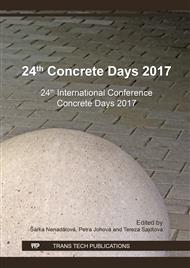p.273
p.280
p.284
p.290
p.299
p.305
p.313
p.319
p.325
Developing of Hydration Heat of the Massive Foundation in the Třinecké Železárny
Abstract:
Heavy industry, industrial plants and technology facilities use really big manufacturing units or assemblies with the weight of tens of tons. In case of rotary kilns, the weight can reach hundreds of tons. During the production process, those units move, creating, in addition to considerable static effects, big dynamic effects. Industrial facilities often face failures of the reinforced concrete foundation which is loaded dynamically by a rotating machine. Such failures typically result in cracks and failures of any of the foundation cross-section. Thus, a part of the foundation starts deviating, the rigidity goes down, geometry of the machine position is changing and an accident may occur - for instance, bearings may fail or malfunctions may occur in the machine. This has also happened in the case described in this article. The subject of the article is the large foundation structure of the rolling device in the Block Mill I in Třinecké železárny a.s. The slab of the foundation structure is approximately a T-shape, which has nearly 43 m in one direction and over 30 m in the other direction. The monolith foundation slab will be 2.0 m thick, the whole foundation structure will be 2.0 - 8.0 m thick. With such an extensive foundation, considerable attention must be paid not only to the design and realization, but also to the effect of the hydration heat.
Info:
Periodical:
Pages:
325-330
Citation:
Online since:
February 2018
Authors:
Price:
Сopyright:
© 2018 Trans Tech Publications Ltd. All Rights Reserved
Share:
Citation:


